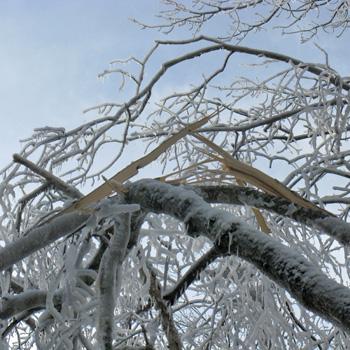Understanding the Impacts of Ice Storms on Forested Ecosystems of the North Eastern and North Central Regions of the United States

Ice storms are a major historical cause of forest disturbance in the northeastern United States and are expected to increase in frequency, severity, and extent in response to climate change. The random nature of ice storms makes predicting their occurrence and studying their ecological effects difficult. To help better understand the impacts of ice storms on northern forest ecosystems, NSRC researchers conducted the first-ever full-forest ice storm manipulation experiment at Hubbard Brook Experimental Forest in the White Mountains of New Hampshire.
Using methods like those used to make snow at ski areas, researchers successfully created ice glaze on tree branches (remarkably similar to conditions during the Northeast’s 1998 Ice Storm) over a large northern hardwood forest area. This novel experimental tool will allow scientists to study controlled icing events of different intensity and frequency in different forest types. Researchers also held a workshop with ecosystem scientists, climatologists, physical scientists, computer modelers, social scientists, and industry experts to define the state-of- knowledge on ice storms and examine the nature and extent of these storms in the Northeast. In addition, they developed machine-learning algorithms which allow computer models to identify unique ice storm climatology in past weather systems to better predict ice storms in the future.
Results from the ice storm climatology work hold promise for forecasting occurrence of these storms and allow land managers and the public to be better prepared. Given the powerful nature of ice storms, results from this study will interest a broad audience of scientists, forest managers, utility companies, and private land owners.
